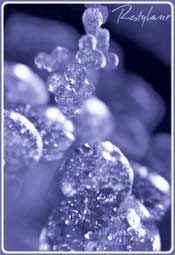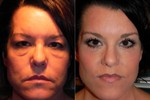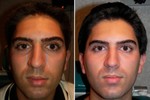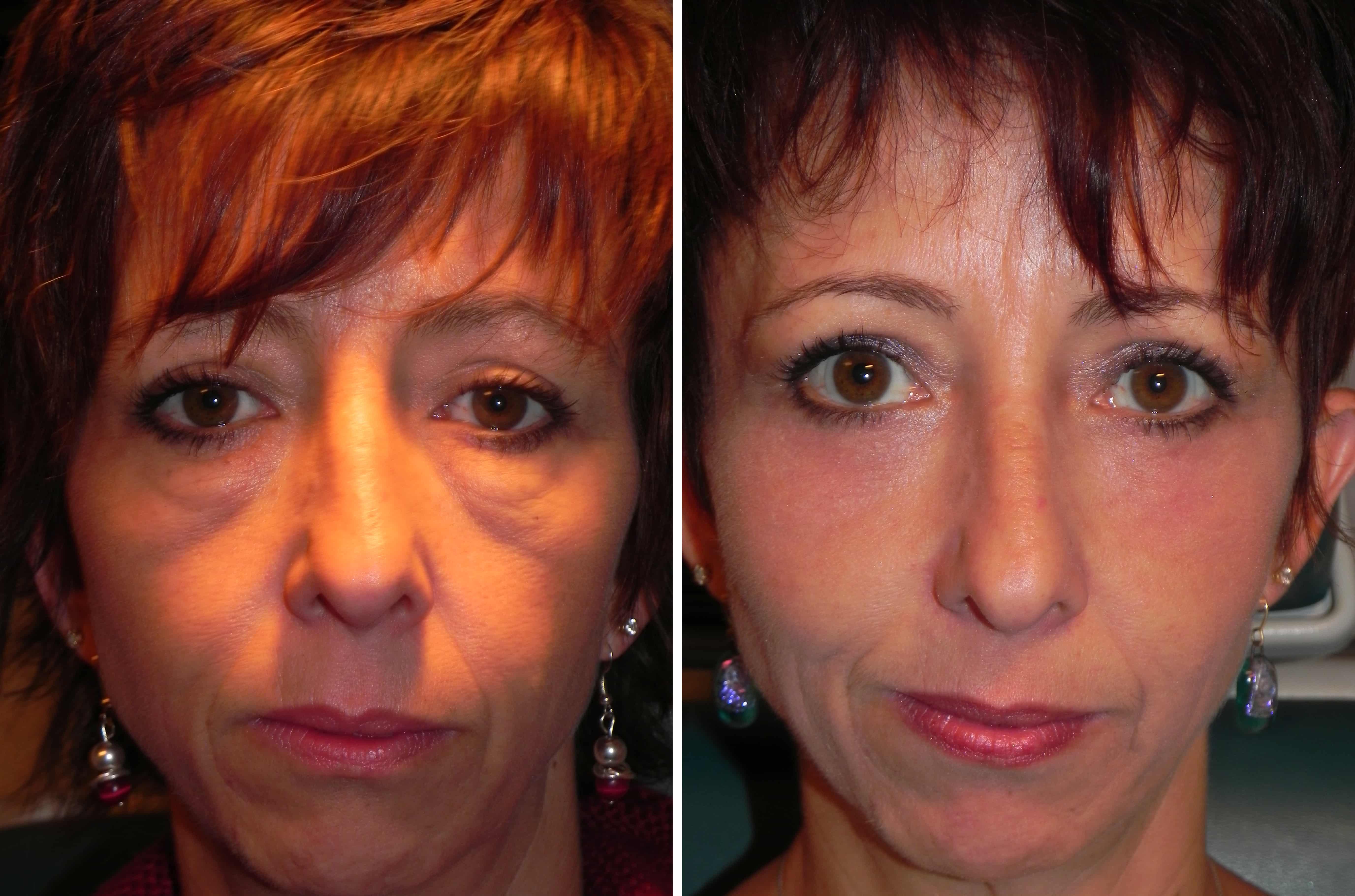Hyaluronic acid fillers such as Restylane®, Juvederm® and Belotero® have been a wonderful tool for doctors and their patients seeking facial rejuvenation. They can be used to fill in wrinkles, levitate deep lines and fix deeper skin folds. When used in special ways, they can help the rebuild sunken parts of the face such as deflated cheeks, shrinking lips, falling brows and jaw lines, and in very specific cases to fill out sunken areas underneath the eyes.
How Fillers Work
Restylane® and the other types of hyaluronic acids are very useful because of the nature of their molecular structure. Hyaluronic acids are a naturally occurring linear polysaccharide, or sugar, found in our bodies. It is a component of all connective tissues and is specifically found in our joints, eyes and our skin. It’s found in nature in almost living species and has a uniform structure across species, which makes adverse allergic or immune reactions rare.
Interestingly, when I was in my medical training, I was involved with learning about how wounds healed in gestation. We used an animal model and explored wounds in developing fetuses and learned that when wounds occurred early in development, they can heal without any discernible scar. It was believed the very high levels of hyaluronic acid naturally present during development in the womb helped facilitate this scarless wound healing.
Hyaluronic acids are naturally present in nature in general and in our bodies specifically. In fact, the first type of Restylane®-like facial filler for aesthetic purposes was a product called Hylaform® and, in true trans-species fashion, it was derived from the comb of a rooster. Even though it was derived from another animal, it was very well-tolerated in humans because of the uniform structure it has throughout nature.
Restylane® itself is derived from a bacterial source. In fact, Restylane® is hyaluronic acid gel generated by the equine or horse strain of the streptococcus species of bacteria. This strain was chosen because it produces a larger amount of hyaluronic acid than other strains. It’s made in a sterile laboratory environment by natural fermentation. The bacteria secrete hyaluronic acid, and this is then processed into Restylane®. There are no actual streptococci in Restylane®.

Hyaluronic acids, like Restylane, have an affinity for water, making it an effective treatment for sunken areas of the face.
One nice factor of using hyaluronic acids in general is their affinity for water. Hyaluronic acids are highly hydrophilic. When water is drawn into a hyaluronic acid, it creates a swelling that gives it an effect larger that its actual size. This can be a big positive when using it to fill sunken areas of the face because a small amount can be used to create a result larger than itself.
This ability of hyaluronic acids to pull water into themselves, while often a positive factor, can also be a negative if they’re injected into risky parts of the face. Although rare, there have been cases where an injection of Restylane® has created enough swelling near a facial blood vessel to occlude its flow and cause downstream skin compromise. In cases like this, it’s good to have another chemical on hand called Hyaluronidase that has the ability to break down hyaluronic acids like Restylane®. This is a naturally occurring enzyme that can also be produced in a laboratory in greater concentrations. It has the ability to degrade hyaluronic acids, making it possible to reverse certain effects caused by Restylane® and other hyaluronic acids.
Lower Eyelid Bags and Fillers
As we age, changes often occur around our eyes. Puffiness and swelling can occur in the area of the upper and especially the lower eyelids. This puffiness, or “bags,” can make us appear tired, sick or old when we often feel fine and energetic inside. Many patients have reported that others tell them they look tired, and my patients often come to see me because they are “tired of looking tired”!
These age-related changes are due to shifting fat in and around the eye region. Fat normally surrounds our eyeballs in the eye socket and is held back by a membrane called the Orbital Septum. As we age, this septum can weaken, causing the fat in the orbit to grow and the eyeball to fall slightly. These changes can push fat that is normally in the eye socket or orbit into the lower eyelid space. This fat in the lower lid is often accentuated by an accompanying loss of fat in the cheek region.
The result of all these changes is puffiness in the lower eyelid region, otherwise known as eyelid bags. This usually appears in the fourth decade of life, but in certain individuals the orbital septum is set forward genetically, resulting in the appearance of eyelid bags early in age. In either case, when others feel we look tired although we feel fine inside, it can be frustrating.
This frustration causes many to seek solutions for their “tired-looking eyes.” Solutions sometimes include home remedies such as Preparation H, ice packs and cucumbers placed on the lower eyelid puffiness.
Unfortunately, these home remedies offer little, if any, effect on the lower eyelid bags. Because this is an anatomical or structural issue behind this condition, more invasive procedures such as surgery are the best option to deal with lower eyelid bags.
Because lower eyelid bags are a structural issue procedures, such as surgery, are the best treatment option.
Improper Use of Fillers
As more patients seek answers for their lower eyelid bags, many seek help from physicians, nurse practitioners and physician assistants of various backgrounds in the cosmetic field.
Many of these medical professionals don’t have the best background in, or full understanding of, the anatomy of the eye area, yet in their attempt to help patients with lower eyelid bags, these practitioners use many different types of fillers like Restylane® in the lower eyelid region to mask the fullness or bags in this area. The result of many of these fillers placed in the lower eyelid region is less than ideal. The intent is valid, but the execution is often faulty. Some problems that occur when Restylane® and other hyaluronic acids are placed improperly in the lower eyelid include abnormal swelling, visible color of the filler through the skin in something called the Tyndall Effect and, rarely, loss of vision or blindness.
Thankfully, Restylane® is a hyaluronic acid and, as such, can be dissolved by Hyaluronidase to improve the above problems. In this way, Hyaluronidase is able to reverse Restylane® under the eyes when problems occur.
In my practice, I take care of patients from all over the world who seek help with rejuvenating their lower eyelids in general and their Festoons and malar mounds more specifically. One thing I’ve noticed over the past many years is how many patients have had fillers placed under the eyes in an attempt to help both their lower eyelid bags and their Festoons and malar mounds. The results as I’ve discussed are often less than ideal because fillers don’t address the true nature of these conditions.
Thankfully, many of the fillers placed are hyaluronic acids like Restylane®, and as a result, I’m able to dissolve these fillers with use Hyaluronidase. In fact, I’ve been using a lot of Hyaluronidase in the past few years to reverse unattractive results from fillers placed underneath the eyes. Reversing Restylane® under the eyes before my surgeries allows me to get a better result for my patients seeking help for their lower eyelid bags, lower lid Festoons and malar mounds.
I do treat patients myself with Restylane® under the eyes, but I only use this in very specific cases when patients are truly hollow under the eyes, as seen in certain young people with a specific genetic predisposition to hollowness in this region.
Fillers like Restylane® are wonderful products to treat many parts of the face, including the lips, cheeks, jaw line, eyebrows and temples, but extreme care must be taken if they are used underneath the eyes because of the often less-than-ideal results that occur when used there. But when patients come to me with lower eyelid bags, lower eyelid Festoons or malar mounds, they are best treated with surgery to improve these condition and not with fillers such as Restylane®.







